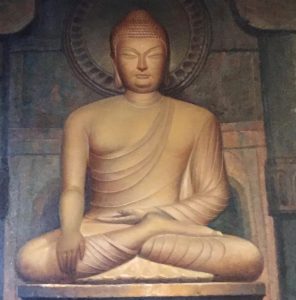
A debate rages these days on whether Jodo Shinshu temples should offer meditation. Proponents say meditation appeals to many people and will attract new members.
In Jodo Shinshu Buddhism, we already are doing meditation, says Toshikazu Arai, professor emeritus of Soai University in Osaka. It’s called nembutsu (also: nenbutsu).
The practice of nembutsu typically is described as saying “the name of Amida Buddha,” recited as “Namu Amida Butsu.” Look deeper and you’ll see that nembutsu is the ultimate form of meditation, Arai says.
Arai states his case in a research paper, called “Nembutsu as the Ultimate Form of Mediation,” which he presented at the 19th Bienniel Meeting of the International Association of Shin Buddhist Studies in Taiwan last May.
In the paper, Arai traces the interpretation of meditation beginning with Śākyamuni Buddha, and how over time different Buddhist masters—namely Nāgārjuna in India, Shan-tao in China, Hōnen and Shinran in Japan—interpreted and evolved that understanding.
Meditation commonly is defined as a practice of “emptying your mind of thoughts and feelings,” and also “to focus one’s mind… for religious or spiritual purposes…” Corresponding Buddhist terms are “meditation” and “contemplation,” according to the paper.
Arai further defines different types of meditation, first using the story of Śākyamuni Buddha. When the Buddha sat under the Bodhi tree until he attained perfect enlightenment, it was a “meditation of seeking.”
Even after attaining enlightenment, the Buddha continued to deepen his understanding of truth and reality throughout his life. Ultimately that understanding came under the calm of meditation, which allowed various blind passions “normally hidden within him (to) reveal themselves and make him realize the reality of himself.” Arai calls this process “meditation of non-seeking.”
By contrast, nembutsu has been interpreted as both a contemplative practice and a verbal practice. Shan-tao elevated verbal nembutsu to a position superior to all other practices, Arai explains, because “the minds of the sentient beings are always scattered, the Buddha provided them with verbal nembutsu so that they could focus their minds on the Buddha. This is exactly what meditation is.”
In Japan, Hōnen flipped the notion that people must first attain right-mindedness before Amida Buddha welcomes them to the Pure Land, to the idea that Amida Buddha comes to help people attain right-mindedness. To make this happen, Hōnen emphasized nembutsu recitation in everyday life.
Shinran takes a big leap in interpreting nembutsu as the “working of Amida’s other-benefitting power” (Japanese: tariki). In this dynamic, people are made to say Nembutsu thanks to the working of Amida’s selected Primal Vow. “This means that our saying the Name is the manifestation of the working of the Primal Vow; as soon as we say the nembutsu, we are embraced in Amida’s meditation.” Arai calls this the “meditation of non-duality,” which he describes as “the ultimate form of meditation.
To read Arai’s complete paper, “Nembutsu as the Ultimate Form of Meditation,” click this link.
Rev. Ken Yamada, editor, Shinshu Center of America

